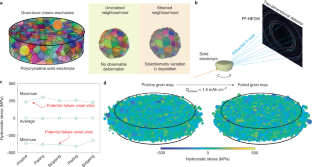2023-01-26 オークリッジ国立研究所(ORNL)
◆ランタノイドは、磁石、電子機器、触媒など、エネルギーおよび国家安全保障技術に不可欠な希土類金属である。ランタノイドは天然に存在する鉱石だが、化学的に類似しているため、個々の元素を分離することは困難である。LLE法は、油や水のような自己分離する液体を利用して対象物質を分離する方法です。例えば、軽ランタノイドと重ランタノイドの分離は、その一例である。今回の研究では、LLE法がどのように展開されるかを説明し、目的の金属の周りに予想外のT字型のクラスターが形成され、それが磁石のように作用してより大きな凝集体を形成することを見いだした。
◆ORNLのAlex Ivanov教授は、「このような原子レベルの詳細な観察は困難であり、将来のレアアース分離戦略の改善に役立つ可能性があります」と述べています。
<関連情報>
- https://www.ornl.gov/news/t-molecules-huddle-around-rare-earth-elements
- https://pubs.acs.org/doi/10.1021/acs.jpclett.2c03423
- https://chemistry-europe.onlinelibrary.wiley.com/doi/abs/10.1002/chem.201806443
非配位性二次球イオンによるランタノイドの超分子クラスター形成の制御 Noncoordinating Secondary Sphere Ion Modulates Supramolecular Clustering of Lanthanides
Darren M. Driscoll, Hongjun Liu, Benjamin Reinhart, Ilja Popovs, Vera Bocharova, Santa Jansone-Popova, De-en Jiang, and Alexander S. Ivanov
The Journal of Physical Chemistry Letters Published:December 22, 2022
DOI:https://doi.org/10.1021/acs.jpclett.2c03423

Abstract
The role of counterions in molecular recognition of lanthanides is underexplored, especially when they exhibit weak interactions with the metal cations. Here, we report a complementary and comprehensive investigation integrating theoretical calculations with X-ray absorption fine structure spectroscopy, dynamic light scattering, and small-angle X-ray scattering to reveal atomic-scale structural features beyond the immediate coordination sphere of a system used for rare-earth element separations. Our results indicate the formation of an unusual T-shaped outer-sphere lanthanide complex, containing two ligands and two nitrate ions in the first coordination sphere, whereas the third nitrate is weakly coordinated and resides in the second shell. This unique structural arrangement causes inhomogeneous charge distribution, leading to self-assembly of the complexes into larger nanoclusters through sterically directed electrostatic interactions in the nonpolar medium. Our findings point to the importance of “noncoordinating” anions in defining the degree of supramolecular aggregation and ion cluster assembly.
ビスラクタムフェナントロリン配位子を用いた軽ランタノイド(III)の効率的分離 Efficient Separation of Light Lanthanides(III) by Using Bis-Lactam Phenanthroline Ligands
Mary R. Healy, Alexander S. Ivanov, Yana Karslyan, Vyacheslav S. Bryantsev, Bruce A. Moyer, Santa Jansone-Popova
Chemistry A European Journal Published: 25 February 2019
DOI:https://doi.org/10.1002/chem.201806443

Graphical Abstract
High fidelity separation: The preorganisation of the four donor atoms as well as the size of the binding cavity in highly rigid 2,9-bis-lactam-1,10-phenanthroline (BLPhen) ligands are the key elements controlling the efficient and highly selective coordination with trivalent lanthanide ions, especially cations with a larger ionic radii (see figure). Moreover, the rigid complexants show extraordinarily high selectivity for light rare-earth elements, even in the presence of competing d-block metal ions, such as Cu2+ and Fe3+.
Abstract
Due to the ever-increasing demand for high-purity individual rare-earth elements, novel and highly selective separation processes are increasingly sought after. Herein, we report a separation protocol that employs shape-persistent 2,9-bis-lactam-1,10-phenanthroline (BLPhen) ligands exhibiting unparalleled selectivity for light trivalent lanthanides. The highly preorganised binding pockets of the ligands allowed for the separation of lanthanides with high fidelity, even in the presence of competing transition metals, in a biphasic separation system. Notably, the selectivity trends of the BLPhen ligands towards metal ions across the lanthanide series can be chemically modulated by altering the molecular rigidity of the extractant.



